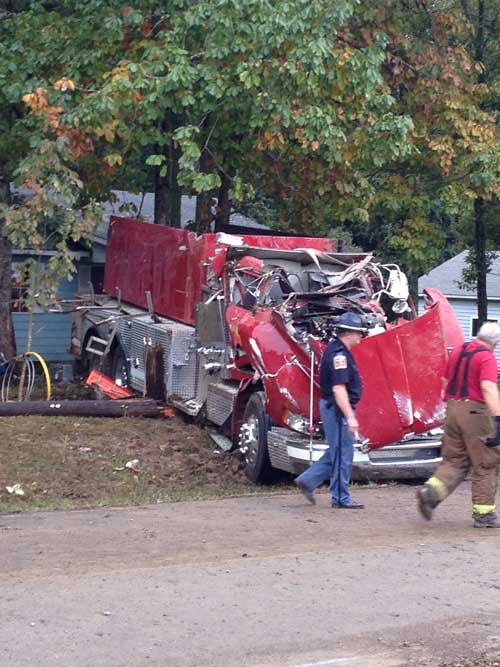Volunteer Fire Department Probationary Member Is Killed After the Pumper/Tanker He Was Operating Leaves the Roadway and Overturns - Alabama
 Death in the Line of Duty…A summary of a NIOSH fire fighter fatality investigation
Death in the Line of Duty…A summary of a NIOSH fire fighter fatality investigation
F2013-26 Date Released: June 4, 2014
Executive Summary
On October 17, 2013, a 28-year-old male volunteer probationary member lost his life after the pumper/tanker he was operating left the roadway and overturned. The probationary member called 9-1-1 to report a structure fire in another house behind his residence. He donned his structural firefighting gear and waited for his department to arrive at the fire. After making an initial fire attack with other fire fighters, he left the hoseline and went to his department’s engine to change the bottle of his self-contained breathing apparatus (SCBA). The pump operator stated she didn’t know where spare bottles were on that apparatus. While still wearing his structural firefighting gear, he left the incident scene in his personal vehicle and responded to his department’s nearby substation. He left the substation driving Engine 2, a 2,500-gallon pumper/tanker. While returning to the incident scene, Engine 2 left the roadway in a curve and overturned. The probationary member received fatal injuries during the rollover and was pronounced dead on the scene. He was not wearing a seat belt.

View of incident scene.
(Photo courtesy of insurance company.)
Contributing Factors
- No department- or state-required driver training program
- Inexperienced driver
- Not wearing a seat belt
- Driving or entering a curve at a speed not negotiable for a large vehicle such as a pumper/tanker
- Exiting a curve on a narrow roadway with a minimal shoulder
- Vehicle overturned
- Incident management system not implemented at the fire scene
Key Recommendations
- Fire departments and authorities having jurisdiction should ensure that all drivers complete a comprehensive driver training program, such as NFPA 1451 Standard for a Fire and Emergency Services Vehicle Operations Training Program, and NFPA 1002 Standard for Fire Apparatus Driver/Operator Professional Qualifications before allowing a member to operate a fire department apparatus.
- Fire departments should ensure that department drivers/operators are trained in the unique characteristics of driving a tanker and maintaining control.
- Fire departments should ensure that seat belts are properly worn at all times by apparatus drivers and occupants.
The National Institute for Occupational Safety and Health (NIOSH), an institute within the Centers for Disease Control and Prevention (CDC), is the federal agency responsible for conducting research and making recommendations for the prevention of work-related injury and illness. In 1998, Congress appropriated funds to NIOSH to conduct a fire fighter initiative that resulted in the NIOSH “Fire Fighter Fatality Investigation and Prevention Program” which examines line-of-duty-deaths or on duty deaths of fire fighters to assist fire departments, fire fighters, the fire service and others to prevent similar fire fighter deaths in the future. The agency does not enforce compliance with State or Federal occupational safety and health standards and does not determine fault or assign blame. Participation of fire departments and individuals in NIOSH investigations is voluntary. Under its program, NIOSH investigators interview persons with knowledge of the incident who agree to be interviewed and review available records to develop a description of the conditions and circumstances leading to the death(s). Interviewees are not asked to sign sworn statements and interviews are not recorded. The agency’s reports do not name the victim, the fire department or those interviewed. The NIOSH report’s summary of the conditions and circumstances surrounding the fatality is intended to provide context to the agency’s recommendations and is not intended to be definitive for purposes of determining any claim or benefit.
